10 Best Cloud HR Software Tools & Systems
Emily Homrok | WorkRamp Contributor
View bioLearning Tips Straight to Your Inbox
Cloud HR Software is a must-have asset for any business—and every industry—in 2024.
Equipped with the right HR software, businesses can speed up employee onboarding, measure employee performance and attendance, administer employee benefits, recruit exceptional talent, and provide effective compliance training that protects against accidents and mitigates risk.
Cloud HR software enables businesses to increase productivity, helps employees complete their tasks, and allows them to find the resources they need on demand.
Improved accessibility isn’t the only advantage that cloud-based HR systems have to offer over their on-premise counterparts, either. Cloud HR software also offers a high degree of scalability, flexibility, and customizability. That explains why, according to sources like Gartner and Business.com, anywhere from 56 to 90 percent of businesses use cloud-based software for HR management.
Learn the ins and outs of cloud HR software to help you choose the best option for your organization. Read on to discover:
- What cloud-based HR software is
- 10 of the best cloud HR systems for businesses
- Essential features to look for when choosing a cloud-based HR platform
- HR trends for businesses to watch in 2024
- FAQs about cloud HR platforms
In this post:
What is cloud-based HR software?
Cloud HR software is a web-based platform organizations can use to manage and automate HR tasks, including human resources management systems (HRMS) and human resources information systems (HRIS).
Cloud-based HR software provides an online solution that enables businesses to manage their HR processes, records, and data using a cloud-based platform.
Unlike traditional or on-premise HR software, which is installed on individual computers or servers, cloud-based HR software is accessible online. That means employees all over the world can log in anytime, anywhere, using virtually any mobile or desktop device. It also means your organization doesn’t need to worry about system maintenance, which the software provider handles.
The main purpose of cloud-based HR software is to streamline and automate HR tasks, making them more efficient and accurate. It serves as a central hub for all HR-related activities and documents, including but not limited to:
- Employee benefits administration
- Employee data management
- New hire onboarding
- Learning and development
- Performance management
- Talent recruitment
By digitizing these processes and moving them to the cloud, businesses can eliminate manual paperwork, reduce their administrative burden, and improve their overall HR productivity. However, to reap these benefits, it is essential to choose software whose features and capabilities align with your organization’s needs.
We will help you make the right decision by comparing some of the leading platforms and their key features.
10 best cloud HR software platforms and systems for 2024
Here are 10 of the best cloud HR software systems to consider for your small, midsize, or large business in 2024:
1. Lattice
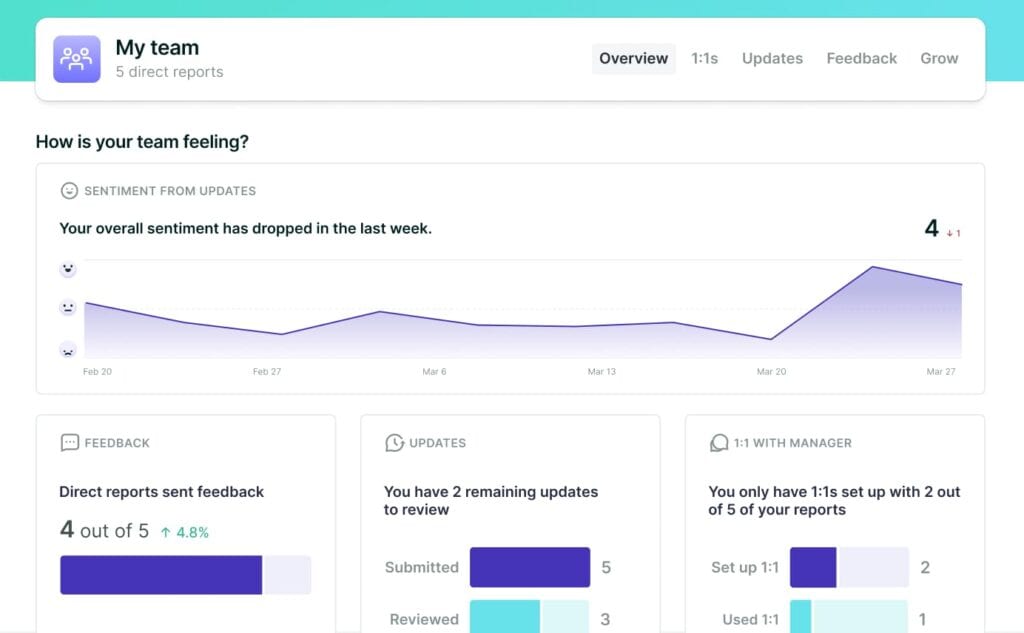
Source: Lattice
Lattice is a cloud-based HR platform designed for companies of all sizes, aiming to streamline HR processes and enhance employee experience.
Described as a “modern performance management solution,” Lattice offers a comprehensive platform that centralizes employee data and facilitates various HR functions.
Key features:
- Performance management
- Goal setting and tracking
- Feedback and recognition
- Employee development
- HR Analytics and reporting
- Integrations
- Onboarding and offboarding
- Employee self-service
- Mobile accessibility
2. BambooHR
 Source: BambooHR
Source: BambooHR
BambooHR is a cloud-based HRIS suitable for small to large businesses that describes itself as a complete HR platform that brings all your employee, payroll, time, and benefit information together in one place.
Businesses can use Bamboo HR to manage and administer employee benefits, onboard and offboard employees efficiently, create custom workflows (such as approval workflows), collect and analyze employee performance data, and more.
Key Features:
- Applicant Tracking System (ATS)
- Custom workflows and approvals
- Employee satisfaction surveys
- Employee self-service resources
- HR reporting and analytics
- Integrations
- Manager and self-assessment tools
- Mobile app
- Onboarding and offboarding tools
- Performance management tools
- Personalized dashboards for admins, employees, and managers
WorkRamp integrates with BambooHR to help you manage employee data by automatically syncing information from BambooHR to your WorkRamp instance.
Integration benefits:
- Streamline logistics with automatic user profile creation
- Admins can spend more time building your LMS strategy and learning programs vs. manually updating employee data
- Ensure learners get the right training content by syncing customer attributes from BambooHR
Learn more about how WorkRamp integrates with BambooHR.
3. Workday
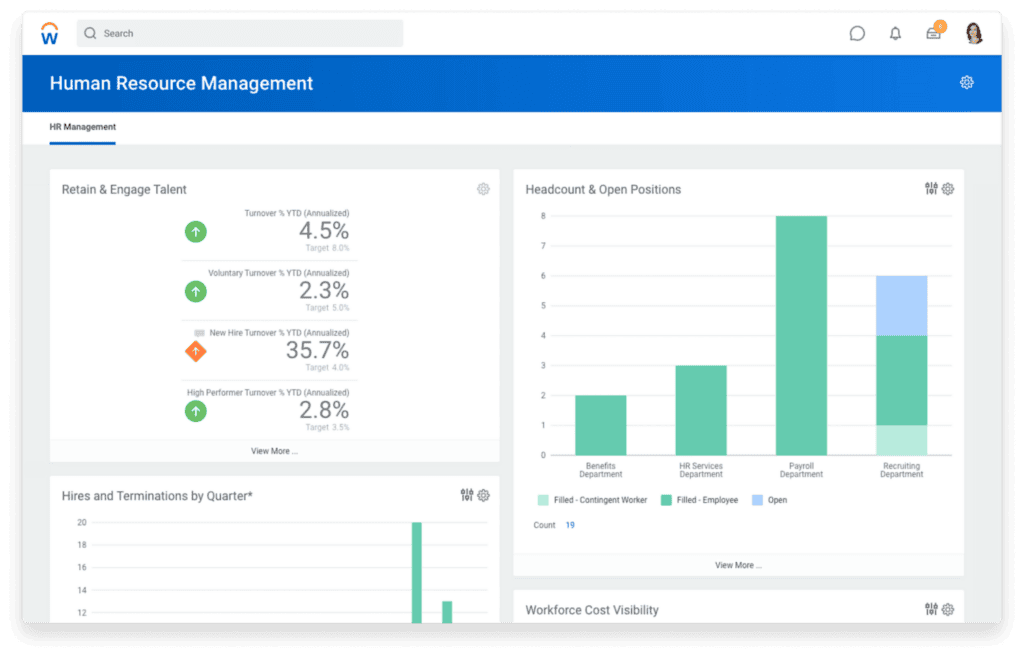
Source: Workday
Workday offers numerous HR products, including solutions for talent management, workforce management and planning, analytics and reporting, human capital management, and human resource management.
Workday helps businesses manage employee data and records, determine employee compensation and benefits, develop talent and leadership, and comply with regulations worldwide.
Workday is suitable for small, midsize, and large businesses. The platform offers industry-tailored solutions for healthcare, manufacturing, finance, and technology/media industries.
Key features:
- AI and machine learning (ML) capabilities
- Audit, compliance, and risk management tools
- Communication and collaboration tools
- Custom content creation tools
- Employee engagement and performance tracking
- Employee self-service resources
- Employee surveys and feedback
- Personalized employee learning and productivity tools, like AI-suggested tasks
- Reporting and analytics
- Talent management tools
WorkRamp integrates with Workday to help you manage employee data in WorkRamp.
Integration benefits include:
- Automatic user profile creation
- Sync custom attributes from Workday
Learn more about how WorkRamp integrates with Workday.
4. Paycor

Source: Paycor
Paycor is a cloud-based HCM platform that includes configurable HR software. Businesses can use Paycor to monitor employee attendance and performance, automate time-consuming, repetitive HR tasks and workflows, collect and provide employee feedback, manage employee records and timecards, and streamline the onboarding process for new hires.
This platform offers industry-specific solutions for the healthcare, manufacturing, restaurant, and professional services industries. However, Paycor is generally better suited for small and midsize businesses than large organizations.
Key features:
- Automated reminders and notifications
- Automated workflows, such as custom hiring workflows
- Collaboration tools like Paycor Engage
- Configurable software that can be tailored to your industry
- Customer sandbox
- Document sharing and employee recordkeeping
- Employee self-service resources
- HR content library featuring forms, tax compliance guides, and more
- Leadership insights
- Mobile app
- Payroll tools like direct deposit and ledger integration
- Performance management tools
- Reporting and analytics
5. Rippling
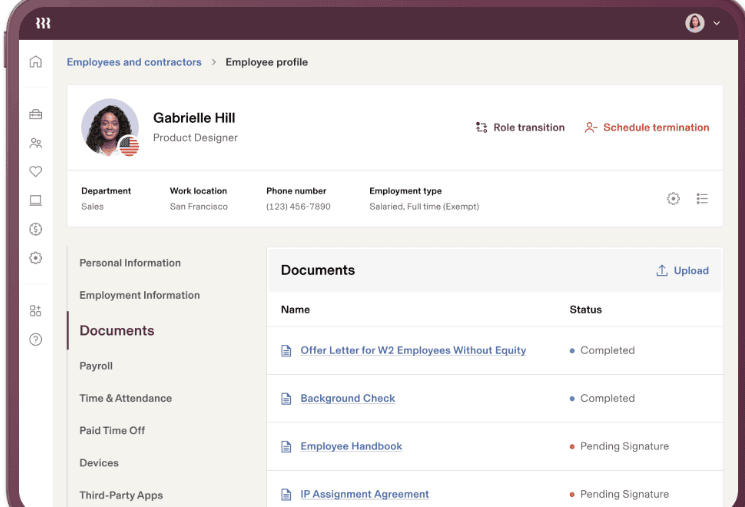
Rippling is a multipurpose workforce management platform with use cases for not only HR, but also finance and IT. When it comes to Rippling’s HRIS software, HR Cloud, the platform offers tools for managing onboarding and offboarding, time and attendance, employee benefits and compensation, and talent recruiting.
Key features:
- Automated tax filing and compliance
- Benefits administration tools
- Compliance training tools
- Course-building tools
- Custom reports
- HR integrations like Slack, Checkr, and Zapier
- PEO services
- Performance management tools
- Pre-built report library
WorkrRamp also integrates with Rippling to give learners quick access to WorkRamp with SSO.
Integration benefits:
- Automatic user profile creation and auto enrollments onto WorkRamp
- Give learners a faster way to sign-in to WorkRamp through Rippling SSO integration
Learn more about how WorkRamp integrates with Rippling.
6. Monday.com
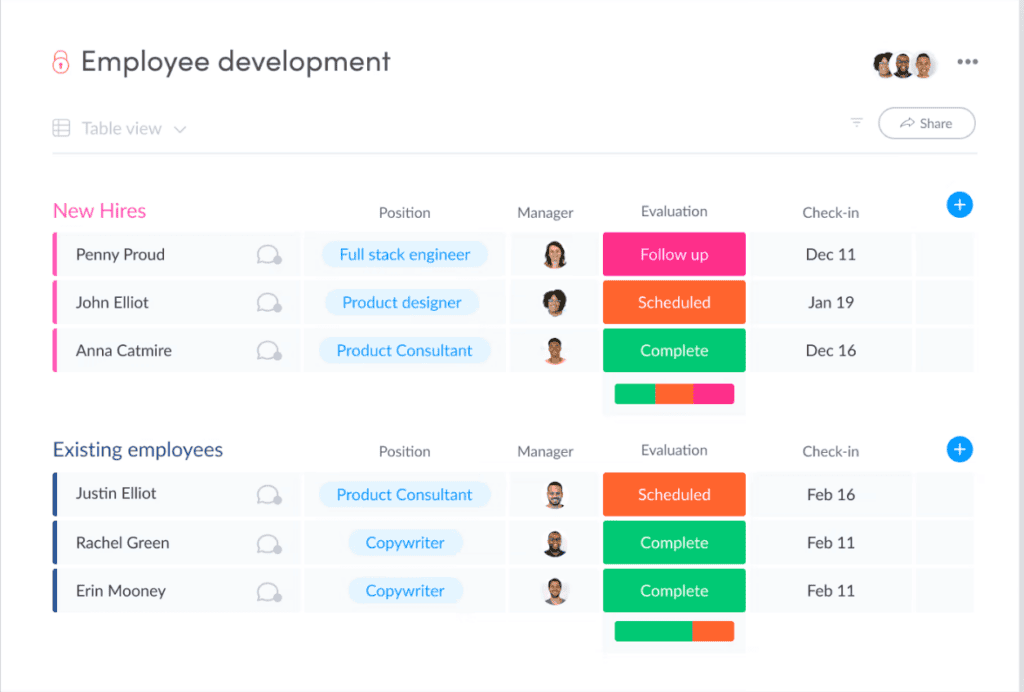
Source: Monday.com
Monday.com is a cloud-based platform that offers three distinct products: Monday Sales CRM, designed for sales and customer-facing teams; Monday Dev, for product development; and—likely most relevant for HR managers—Monday Work Management, which has use cases for task, resource, project, and portfolio management, along with goal-tracking and business ops planning.
HR professionals can use Monday’s employee management system to create custom workflows, visualize tasks and data, improve recruitment procedures, speed up onboarding, manage employee leave and vacation requests, and more.
Key features:
- Ability to automate repetitive tasks
- Automatic reminders and notifications
- Basic and advanced reporting
- Custom dashboards
- Data visualizations
- Employee development and learning tools
- Integrations with Google Drive, Slack, Gmail, and more
- Pre-built HR templates, like attendance and feedback trackers
7. ADP Workforce Now
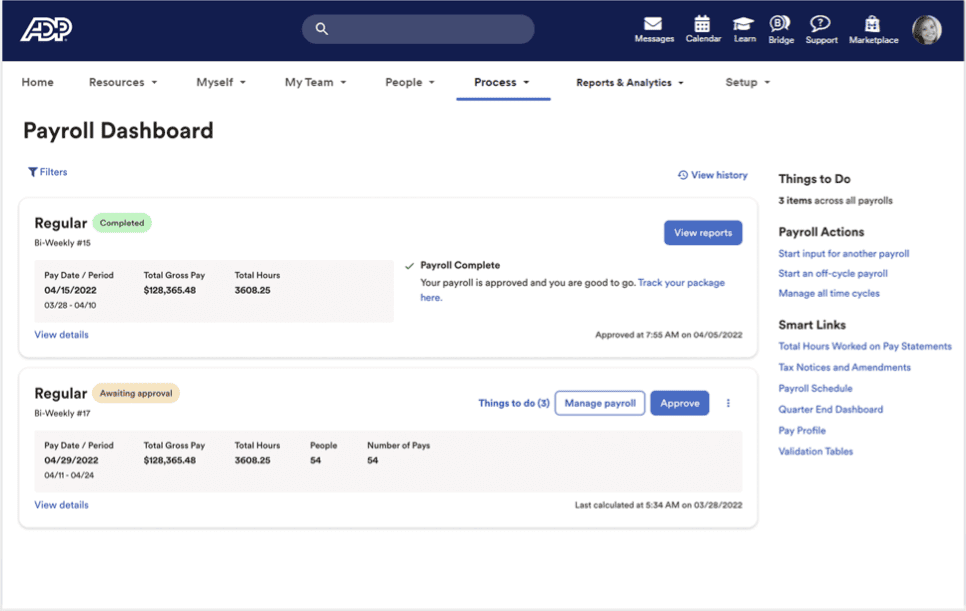
Source: ADP
ADP describes ADP Workforce Now as “our all-in-one platform for payroll and HR software, providing expert support and analytics for data-driven insights.”
HR professionals can use ADP Workforce Now to maintain digital records, automate various aspects of compliance (such as tax filing), streamline the onboarding process for new hires, and analyze trends to make data-driven decisions.
Key features:
- Accurate time-tracking tools
- Analytics and reporting
- Configurable onboarding tools
- Customizable dashboards to manage employee data
- Customizable employee feedback surveys
- Employee development and training courses
- Employee self-service tools
- Payroll management features
- Reminders, announcements, and notifications
8. Sage HR
Sage HR is a cloud-based human resource management platform suitable for small to midsize businesses looking to attract, engage, and nurture the best talent, all from one place.
Businesses can use Sage HR to streamline onboarding, build custom HR workflows, gain insights into employee performance, track expenses and timesheets, and make HR documentation and other resources easy to access for employees.
Key features:
- Centralized employee information database
- Custom workflow builder to automate various tasks
- Electronic signature capabilities
- Integrations with popular software
- Interview scheduling tools
- Multiple languages supported
- Pipeline management tool to simplify hiring
- Productivity-tracking tools
- Reporting and analytics
- Schedule- and shift-planning modules
- Tools for broadcasting company-wide announcements
9. SAP SuccessFactors

Source: SAP
According to SAP’s website, SAP SuccessFactors HXM Suite provides cloud-based solutions, such as a human resource management system (HRMS), that connect core HR and payroll, talent management, sales performance management, people analytics, and workforce planning.
Some examples include SAP SuccessFactors Workforce Analytics, SAP SuccessFactors Work Zone, SuccessFactors Employee Central, and SAP SuccessFactors Time Tracking.
Key features:
- Ability to create customized employee learning experiences
- Collaboration and communication tools
- Employee benefits administration and management tools
- Employee self-service resources
- HR compliance management tools
- Flexible configuration options
- Payroll management tools
- Pre-built HR forms and templates
- Integrations with third-party software
- Time-tracking capabilities
10. Gusto

Source: Gusto
Gusto is a cloud-based HR platform that delivers automated workflows, one-stop recruiting, hiring, and onboarding, and a full suite of time and performance tools, according to its website. Gusto is suitable for businesses of all sizes, with dedicated solutions for single-employee businesses, independent contractors, and global or remote businesses.
Key features:
- Hiring and onboarding tools
- Insights and reporting
- Integrations with popular software like Trello, Asana, and Shopify
- Payroll features like automatic tax filing
- Talent development and employee performance management tools
- Time- and attendance-tracking features
WorkRamp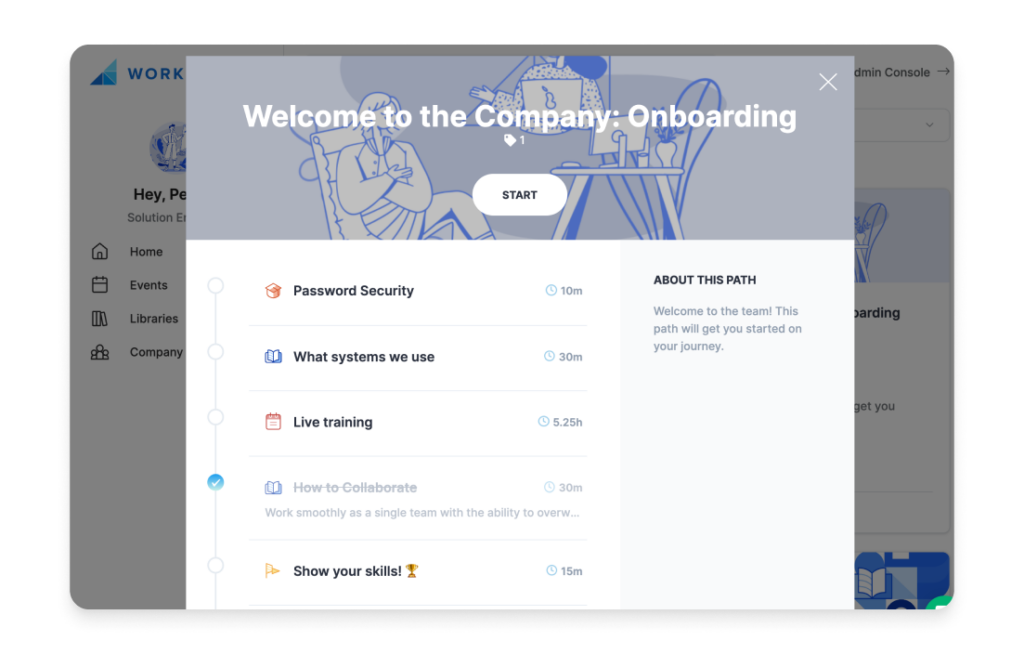
Unlike the other platforms on this list, WorkRamp is not an HRIS. Instead, WorkRamp is a cloud-based learning platform that helps you enrich the employee experience by creating a learning culture to empower your teams.
Get new hires up to speed faster with engaging onboarding programs, mitigate risk and protect employees and your organization with compliance training, support employee mobility with leadership development, and upskill and retain team members with employee development programs.
WorkRamp also integrates with commonly used HR tools including BambooHR, Rippling, and WorkDay.
A learning management platform like WorkRamp is valuable to have alongside an HRIS.
Here are just a few examples of what you can do with WorkRamp’s secure, scalable platform, which is designed for businesses of all sizes:
- Employee onboarding: Create custom groups to streamline onboarding for multiple new hires and track new hires’ engagement and performance with recurring reports for managers
- Employee development: Upskill and reskill employees to close skill gaps. Assign role-based learning paths, design personalized employee training programs and certification courses, including sales training and new manager training, and empower employees with comprehensive self-service resources
- Leadership development: Cultivate the next generation of managers and leaders
- Compliance training: Deploy annual compliance training that protects your organization and educates employees about issues like workplace safety, diversity and inclusion, sexual harassment, and the laws and regulations affecting your industry, such as HIPAA
- Manage and centralize training materials: Centralize learning while ensuring consistency across all training materials
Key features:
- Advanced reporting and analytics to show the ROI of your training programs
- Automated workflows
- Pre-built training content library featuring more than 85,000 courses
- Course and content creation tools
- Custom branding
- Employee self-service tools, including self-assignments
- Integrations with BambooHR, Rippling, Workday, and other HR platforms
- Interactive training features and content
- Intuitive, easy-to-navigate interface
- Learner assessments, tests, and quizzes
- Mobile app for on-the-go access
- Robust security features like 256-bit AES encryption
- Searchable, centralized file and document storage
Learn more about how WorkRamp can help you achieve your employee training goals, from onboarding and compliance training to leadership development.
How to choose the best cloud HR system: essential features to look for
With such a wide array of cloud HR systems, it’s easy to get overwhelmed by decision paralysis.
Things to consider in an HRIS:
Self-service access
Employee self-service is a critical feature that empowers team members to access and manage their own HR information. It allows employees to update personal details, submit time-off requests, view pay stubs, and access company policies and training materials.
Self-service functionality reduces administrative burden and increases employee satisfaction by enabling team members to take control of their HR-related tasks.
Affordability
Look for software that offers transparent (and affordable) pricing models with no hidden fees or long-term commitments to lock you in. Consider both the initial implementation costs and ongoing maintenance and support fees.
Remember to evaluate the value that the software brings to your organization and how it aligns with your overall budget and business priorities.
Integration capabilities
Integrations enable information to flow seamlessly between your cloud HR software and the other systems in your tech stack, such as payroll, time and attendance, or performance management systems. That makes it crucial to choose software that offers either pre-built integrations or open APIs that allow you to connect with your existing tools.
By choosing HR software that offers third-party integrations, you can eliminate manual data entry, reduce the likelihood of errors, and improve the accuracy and consistency of your organization’s data.
Things to consider in an LMS:
Learning management capabilities
Learning management tools are essential for organizations prioritizing employee training and development.
A quality LMS like WorkRamp will help you develop and deliver engaging, personalized training programs, ensuring your workforce has the necessary skills to succeed.
Learn more about WorkRamp’s purpose-built employee LMS and how it can help you scale learning across your org.
Compliance training offerings
Compliance training is crucial for businesses, especially those operating in regulated industries.
Make sure the cloud HR software you choose includes compliance training features, such as the ability to create and deliver compliance courses, track completion, and generate compliance reports. This will help you ensure that your employees are up to date with the latest regulations and minimize the risk of fines or penalties resulting from non-compliance.
Learn more about how you can deliver effective, engaging compliance training with WorkRamp.
Analytics and reporting
Analytics and reporting features are essential because they provide actionable insights, empowering your organization to make strategic, data-driven decisions.
When choosing cloud-based HR software, look for a platform like WorkRamp that offers a robust set of reporting tools, including customizable dashboards and pre-built reports.
Advanced reporting features enable you to track key HR metrics like employee turnover and retention, cost per hire, employee productivity, and overtime expenses; identify trends, sentiments, and skill gaps; and measure the effectiveness and ROI of your HR initiatives.
Benefits of using cloud HR software and apps
Cloud-based or SaaS HR software offers various benefits for businesses—for example, ensuring that employees can always access company resources online, regardless of their time zone or geographic location.
Let’s take a closer look at how cloud-based HR improves accessibility, plus two other benefits this type of software provides.
Accessibility
One of the primary benefits of cloud HR software is its accessibility. Since it is hosted in the cloud, it can be accessed anytime, anywhere with an internet connection.
This allows remote employees, field workers, and global teams to easily access and update their HR information. Cloud HR software’s accessibility promotes collaboration, eliminates geographical barriers, and enhances the overall employee experience.
Flexibility and customization
In contrast to traditional, on-premises HR software, which often requires extensive tech support, SaaS or cloud-based HR software can be easily configured to align with your specific HR workflows.
Your admins can add or remove modules, define user roles and permissions, customize fields and forms, and more.
Scalability
Growing businesses require evolving HR solutions. Cloud-based HR software is flexible and scalable, enabling you to make user, module, and feature adjustments as your organization expands and develops.
For example, you can add users and edit permissions as your team grows or add new plugins to the platform you use.
Whether you’re expanding your team or entering new markets, cloud HR software is nimble and versatile enough to meet your changing needs—without the burden of costly infrastructure investments or system updates. This adaptability helps guarantee that your HR operations align with your business goals.
Cloud HR software trends in 2024
Here are a few of the developing HR trends that businesses need to stay ahead of in 2024:
- A growing need to balance human connections with the ever-increasing use of artificial intelligence (AI)
- Increasing prioritization of employee well-being and mental health
- Decreasing emphasis on attendance culture and increasing emphasis on performance culture, making performance management tools essential for businesses
More about cloud HR software
We answered a few of your most common questions about HR software and the solutions it provides for businesses.
Which is the best HR software?
Every organization has different software needs. Ultimately, the “best” HR software is one that fits your budget, addresses your organization’s pain points, and includes the features that will help you reach your company’s goals.
What is Saas HR software?
The acronym SaaS stands for “software-as-a-service.” Small, midsize, and large companies can use SaaS software to manage a wide range of HR tasks, including but not limited to employee data, payroll, benefits administration, talent recruitment, performance management, and employee training—all through a mobile-friendly, web-based platform.
By leveraging SaaS HR software, companies can accelerate their HR processes, eliminate repetitive tasks, and increase their productivity.
Are there different types of cloud-based HR software?
There are five broad categories of HR software, known as Human Resource Information Systems (HRIS), which may be cloud-based or hosted on-premises, depending on the platform.
These categories are comprehensive HRIS, operational HRIS, strategic HRIS, tactical HRIS, and limited-function HRIS. Some examples of cloud-based or SaaS HR platforms include Workday, Paycor, and BambooHR.
What is cloud-based HCM software?
The acronym HCM refers to “human capital management.” Examples of cloud-based HCM software to consider in 2024 include Rippling, BambooHR, SAP SuccessFactors, and more.
Remember, the right cloud-based HCM software for your organization should not only help you advance your business goals but also offer cost-efficiency and ease of implementation.
Choose the best cloud HR software
Say goodbye to expensive, ineffective training programs and time-consuming manual tasks. Get better ROI from your HR initiatives with an easy-to-use, ultra-customizable, mobile-friendly platform that securely stores your organization’s data and records.
Learn more about how WorkRamp complements your HR software to help you promote employee engagement and development.
Contact us today to schedule a free, personalized demo.
Complete the form for a custom demo.
Recent Posts
- Introducing WorkRamp Analytics Studio: Unlocking Your Data Insights with AI June 30, 2025
- 11 AI LMS for AI-Powered Learning June 27, 2025
- The Best LMS Platforms for Customer Retention (2025 Guide) June 27, 2025
- 11 Best AI Learning Platforms June 16, 2025
- Top AI LMS Features (and Why They Matter in 2025) June 16, 2025
Emily Homrok
WorkRamp ContributorYou might also like
What are the benefits of online learning?
When it comes to professional development and continued learning, online courses and programs offer several advantages over traditional in-person options.
Read More
Great feedback can be transformative, setting up your team and company for success
Effective feedback is rarely given, leaving missed opportunities for improvement and growth. Discover 11 best practices to reap the benefits of giving and receiving employee feedback.
Read More
Leveraging L&D to set your team up for success
Use these L&D strategies to future-proof your organization and retain skilled team members.
Read More
Decrease Ramp Time and Increase Revenue
Get in touch to learn how WorkRamp can help you achieve your learning and development goals.
Request a Demo




